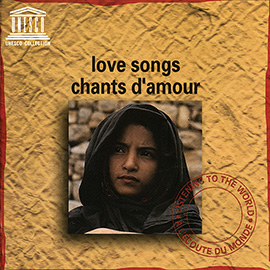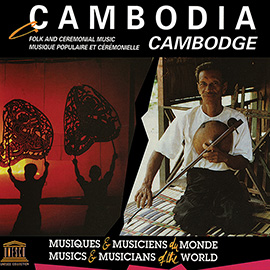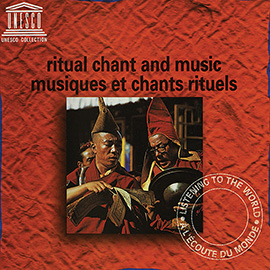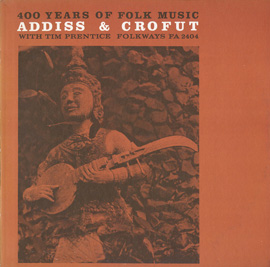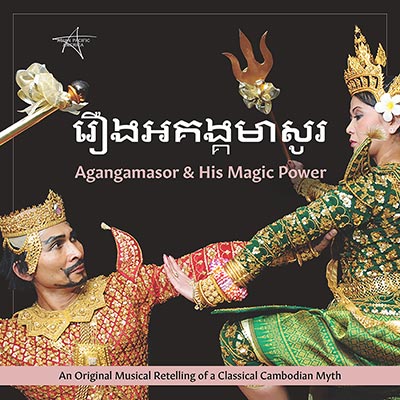Summary
Through active listening, discussions of cultural context, and re-creating ostinati and pentatonic melodies, students will experience two contrasting examples of the music of the Khmer people of Cambodia.
Suggested Grade Levels: 6-8
Country: Cambodia
Region: Southeast Asia
Culture Group: Khmer
Genre: Festival & Wedding Music
Instruments: Alto recorder, alto xylophone, drum, cowbell, cymbals, chhayam (large drum), kong mung (gong), chhap (hand cymbals), tro khmer (three string fiddle), khse diev (single string lute), chapei veng (two string lute), chhing (small cymbals), skor arak (small drum)
Language: Khmer
Co-Curricular Areas: Geography, Social Studies
National Standards: 2, 6, 7, 9
Prerequisites: Intermediate alto recorder skills (or other treble instrument such as violin, flute, or xylophone), beginning mallet skills, beginning to intermediate percussion skills.
Objectives:
- Critically listen to and analyze two examples of music of the Khmer people of Cambodia (Standards 6, 7)
- Discuss the roles of music in Cambodian culture (Standard 9)
- Play pitched and un-pitched instruments (Standard 2)
Material:
- Audio equipment suitable for listening selections.
- Map of Southeast Asia.
- Two sets of twenty five index cards (or adequate numbers for each student).
- One set with any simple symbol of a single person singing (caller)
- Alto recorders, alto xylophones, drums, cowbells, and cymbals.
- “Krom phleng kar: Hom rong” and “Chhayam,” from Cambodia: Traditional Music, Vol. 1:Instrumental and Vocal Pieces, FW04081.
- The other with symbols of several people singing (response)
- Note: the following quote is taken from page five of the liner notes of this album, which was produced in 1978. “This album is dedicated to the memory of the Cambodian people who have suffered senselessly and have lost their lives to war.” This quote may well serve as a poignant introduction to the journey of the Khmer people of Cambodia to America in this tragic time in their history.
Lesson Segments:
- Where’s the Party? (National Standards 6, 7, 9)
- Party Time! (National Standards 2, 3, 6, 7)
- Accent on Drumming (National Standards 2)
- Here Comes the Bride (National Standards 2, 9)
Lesson Segment #1: Survey of Ghanaian Musical Expressions
Procedure:
- Students will listen to the first 30 sec. of the recording “Chhayam” and identify sounds that they hear [male voices, drum (chhayam), gong (kong mung), hand cymbals (chhap)].
- Possible questions include, “Where might this music be from?” (Cambodia) “What is the mood?” (possible answers include exciting, invigorating, energetic) “Could you imagine this music at a party?”.
- With teacher guidance, students will locate Cambodia on a map and identify neighboring countries.
- Students will listen to the first 30 sec. of the recording “Krom phleng kar: Hom rong”, and identify sounds that they hear [string instruments, cymbals, drum: three string fiddle (tro khmer), single string lute (khse diev), two string lute (chapei veng), small cymbals (chhing), small drum (skor arak)].
- Possible questions include, “how many instruments begin this song?” (one) “What is the mood?” (possible answers include calm, restful, relaxed) “Could this be party music, too?” “Are they similar in mood, or are they contrasting?” (they contrast).
- Students will listen to both recordings, tapping out a beat.
Assessment:
- Students will respond to questions and via musically appropriate movement (the tapping of the beat) to the musical selection.
Lesson Segment #2. Party Time!
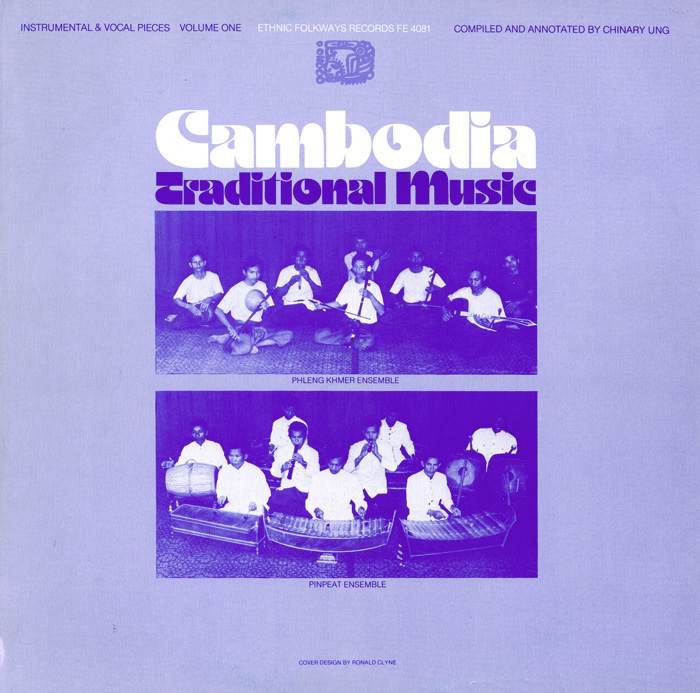
“Krom phleng kar: Hom rong”
from Cambodia: Traditional Music, Vol. 1: Instrumental and Vocal Pieces (1975) | FW04081
“Chhayam”
from Cambodia: Traditional Music, Vol. 1: Instrumental and Vocal Pieces (1975) | FW04081
Procedure:
- Students will listen to “Chhayam” clip while standing and walking in place to the beat, listening for the accent in the drum.
- Question: “Does the accent happen on or off the beat?” (off the beat) “Can you clap the rhythm of the drum while walking to the beat?” “Do the other instruments keep a beat throughout or do they change?” (the instruments change, with the exception of the gong (kong mung), which maintains a beat) See album liner notes by Dr. Chinary Ung for important background on the musicians, concept of time, and the relationships of “space and elasticity.” “What is the form of the chanting?” (call and response)
- After distributing “call and response” index cards, students will listen to “Chhayam” while holding up the appropriate card.
- Teacher will lead practice of vocal chants (on the recorded music, chants are improvised vocables).
- Teacher will introduce song’s function: Buddhist festival music (Bon Kathhen-the emergence of monks from a three month retreat, and Bon Phka-flower festival held from the end of the harvest until the onset of the wet season).
- Students will listen to “Krom phleng kar: Hom rong” clip while humming the opening solo and quietly tapping the beat. Students will raise their hand when they hear instruments enter.
- Question: “Are there clear delineations of sound?” (With the exception of the single melody at the beginning, no. The sounds overlap and intertwine) “After the opening solo, does a clear melody re-emerge?” (no)
Extensions:
6. Students will create their own call and response chants (Standard 3).
Assessment:
- Students will elicit musically appropriate movement and chanting.
Lesson Segment #3. Accent on Drumming
Procedure:
- Students will listen to “Chhayam” clip while clapping the drumming pattern.
- Students will practice pattern on drums, emphasizing accents.
- Teacher will lead practice of vocal chants.
- Teacher will introduce and rehearse cymbal and cow bell parts.
- Students will listen to “Krom phleng kar: Hom rong” clip while humming and showing the melodic contour of the opening solo with their hand.
- Teacher will lead guided discussion of comparisons of the two pieces (tempo, mood, instrumentation).
- Teacher will introduce and rehearse “Krom phleng kar” arrangement.
Assessment:
- Teacher will record practice sessions (letters b through d) and ask students to evaluate their work.
Lesson Segment #4. Here Comes the Bride
Procedure:
- Students will practice “Chhayam” arrangement, including vocals.

- Students will practice “Krom phleng kar,” including alto recorder line.

- Teacher will introduce song’s function: Buddhist wedding music. Weddings are traditionally three days long, and this song is the introductory music. It is interesting to note that the music parallels the outcome of the wedding ceremony: it begins with a single sound, and ends with joined sounds. See liner notes for more background information.
- Students will listen to “Krom phleng kar” recording, raising their hands when they hear fragments of the two phrases of the arrangement’s ostinato.
- Teacher will lead guided discussion of improvisation, ornamentation and Khmer music. Again, see liner notes!.
Extensions:
- Students will improvise on the alto xylophone ostinato.
- Students will ornament the alto recorder part.
- Students will study other festive musics and create a concert program or CD.
Assessment:
- Teacher will record practice sessions (letters a and b), play previous “Chhayam” practice session from lesson three, and ask students to evaluate their progress on “Chhayam” and assess their work on “Krom phleng kar.”



